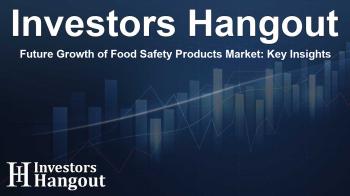Future Growth of Food Safety Products Market: Key Insights

Overview of the Food Safety Products and Testing Market
The food safety products and testing market presents a compelling growth story, with its projected valuation soaring from USD 2.62 billion in 2025 to an impressive USD 4.47 billion by 2032. This remarkable increase corresponds to a compound annual growth rate (CAGR) of 7.9% throughout this period. The fundamental drivers behind this positive trend primarily include stringent government regulations aimed at reinforcing food safety and rising consumer awareness concerning foodborne illnesses.
Market Growth Drivers
Increase in Foodborne Illnesses
One of the most concerning aspects impacting the food industry today is the rise in foodborne illnesses. According to studies, unsafe food leads to an alarming 600 million cases of foodborne diseases globally each year, resulting in around 420,000 fatalities. This startling statistic stresses the critical need for robust food safety measures, motivating manufacturers to adopt advanced testing solutions to safeguard public health.
Government Regulations
Governments worldwide are heightening food safety regulations, with mandates like the Hazard Analysis Critical Control Point (HACCP) and ISO 22000 gaining prominence. These regulations not only entail regular testing of food products but also emphasize the necessity for producers to implement improved safety protocols. For example, the U.S. Food Safety Modernization Act has placed increased focus on preventive measures and routine inspections in food facilities, ultimately bolstering the demand for food safety solutions.
Key Market Segments
Segments by Testing Type
Delving into market segmentation, microbiological testing stands out as a vital contributor, expected to dominate with a share of around 26.6% by 2025. Other crucial testing categories include chemical, nutritional, allergen, and genetically modified organism (GMO) testing, each catering to different consumer needs and industry standards.
Application Insights
Focusing on application, meat, poultry, and seafood products are projected to account for nearly 40% of the overall market share by 2025. The growing focus on food safety in these sectors is primarily driven by the higher risks associated with handling raw materials, necessitating thorough testing for pathogens and contaminants.
Emerging Trends in Food Safety
Technological Advancements
The integration of innovative technologies is revolutionizing the food safety landscape. New advancements such as polymerase chain reaction (PCR) assays and rapid testing kits are optimizing detection capabilities for contaminants, allowing for quicker turnaround times in testing and improving overall efficiency within food production chains.
Consumer Demand for Transparency
Today’s consumers are demanding greater transparency regarding the origins and safety of their food. This trend urges food producers to adopt comprehensive testing practices, which helps to uphold their brand reputation and build consumer trust. As people increasingly gravitate towards convenient, packaged options, the need for rigorous safety testing solutions continues to amplify.
Challenges Facing the Market
Cost of Advanced Technologies
Despite the promising outlook, the food safety products and testing market faces challenges, particularly concerning the high costs associated with advanced testing technologies. Solutions like liquid chromatography mass spectrometry (LC-MS) are prohibitively expensive for smaller firms, which may restrict their ability to compete in an increasingly technology-driven space.
Conclusion
The future of the food safety products and testing market is bright, supported by the need for stringent safety regulations, rising foodborne illness cases, and evolving consumer preferences. Companies are continuously seeking innovative products to meet these demands, signaling ongoing growth opportunities in this essential sector.
Frequently Asked Questions
What is the expected growth of the food safety products market?
The food safety products market is projected to grow from USD 2.62 billion in 2025 to USD 4.47 billion by 2032 at a CAGR of 7.9%.
What are the primary factors driving market growth?
The main factors include increasing foodborne illness cases, stricter government regulations, and growing consumer demand for food safety.
Which segment is expected to dominate the market?
Microbiological testing is anticipated to be the leading segment, capturing around 26.6% of the market share by 2025.
How do regulations impact the market?
Regulations such as HACCP and ISO 22000 mandate regular testing, pushing food manufacturers to implement advanced testing solutions.
What challenges does the food safety market face?
High costs associated with advanced testing technologies may hinder participation from smaller companies, potentially impacting overall market growth.
About The Author
Contact Logan Wright privately here. Or send an email with ATTN: Logan Wright as the subject to contact@investorshangout.com.
About Investors Hangout
Investors Hangout is a leading online stock forum for financial discussion and learning, offering a wide range of free tools and resources. It draws in traders of all levels, who exchange market knowledge, investigate trading tactics, and keep an eye on industry developments in real time. Featuring financial articles, stock message boards, quotes, charts, company profiles, and live news updates. Through cooperative learning and a wealth of informational resources, it helps users from novices creating their first portfolios to experts honing their techniques. Join Investors Hangout today: https://investorshangout.com/
The content of this article is based on factual, publicly available information and does not represent legal, financial, or investment advice. Investors Hangout does not offer financial advice, and the author is not a licensed financial advisor. Consult a qualified advisor before making any financial or investment decisions based on this article. This article should not be considered advice to purchase, sell, or hold any securities or other investments. If any of the material provided here is inaccurate, please contact us for corrections.

